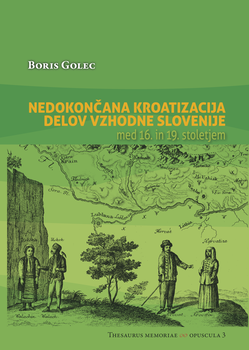Nedokončana kroatizacija delov vzhodne Slovenije med 16. in 19. stoletjem. Po sledeh hrvaškega lingvonima in etnonima v Beli krajini, Kostelu, Prekmurju in Prlekiji
What is more, in recent decades publications of various sources have provided confirmation of the presence of the name ‘Croatian’ in two other Slovenian border areas: as a linguonym and ethnonym in Prekmurje, and only as a linguonym in Prlekija. Using comparative methods and drawing on the widest possible spectrum of sources, this discussion sheds light on the reasons for the appearance and disappearance of the term ‘Croatian’ in four Slovenian border areas. Its main conclusion is that the term ‘Croatian’ in the areas under discussion established itself as a transitional phenomenon substituting for the original term ‘Slovene’(noun) or ‘Slovenian’ (adjective), the area being at the time replete with “prenational" significance and embraced by a good part of modern Croats as their own. The spread of the term ‘Croatian’ to the Slovenian border areas was part of a broader and prolonged process of nominal Croatization of medieval Slavonia (in present-day northern Croatia) with its center in Zagreb; such was taking place against the backdrop of tectonic geopolitical shifts resulting from Ottoman territorial gains in the Balkans and the Pannonian Plain in the fifteenth and sixteenth centuries. In the historically Slavonian territory, thenceforth even more closely tied to the remnants of the original Kingdom of Croatia (in the Adriatic area), the designation ‘Croatian’ had been established by the eighteenth century in place of the previous designation ‘Slovene’, first as a political designation for the territory and its inhabitants and only later on as a designation for its language, Kajkavian (today a Croatian dialect), which was still called ‘Slovene’ for a long time to come.
The fundamental questions in this discussion are why the term ‘Croatian’ was also able to establish itself in part of the Slovenian territory in the early modern era and why it disappeared with the passage of time. The three areas under discussion – Prlekija, Prekmurje, and White Carniola – were the last to be included together with the rest of the Slovenian ethnic territory in a shared state framework: White Carniola and Prlekija circa 1300, and Prekmurje no earlier than 1526. However, they were never an integral part of historical Croatia nor had they been settled by a population that would call their language Croatian and themselves Croats. On the other hand, for centuries all four of these border areas fostered a lively cultural interaction with present-day Croatian territory, which was facilitated above all by language similarity and, in the case of Prekmurje, a shared Hungarian political framework. In all four areas in the early modern era, the combination of two closely interrelated factors – the linguistic factor and the cultural-linguistic factor – led to different degrees of Croatization of the linguonym ‘Croatian’ and in three areas also to the appearance of the ethnonym ‘Croats’; however, in the eighteenth century both began to dwindle rapidly and eventually died out.
The reasons for the establishment of the term ‘Croatian’ in place of the original ‘Slovene’ were similar in all four border areas under discussion but also specific to each one. The areas differed with respect to the time frame in which the term ‘Croatian’ was documented and also with respect to its rootedness. The designation first appeared in Kostel, as early as the end of the sixteenth century (1598), last in Prlekija, being no earlier than the beginning of the eighteenth century, and was documented for the longest period in the southernmost part of Prekmurje (1811). The ethnonym ‘Croats’ and linguonym ‘Croatian’ gained the most ground in White Carniola and Kostel; in Prekmurje, they reached various degrees of acceptance, depending on the ecclesiastical as well as religious division of the area, whereas in Prlekija, there were only records of the linguonym. The dwindling and disappearance of the term ‘Croatian’ until circa 1800 related to a number of factors. A very important role was played by political-administrative and ecclesiastical reforms that pulled the border areas under discussion from Croatian cultural and educational centers, and the emergence of two Slovenian regional standard languages – the Prekmurje and eastern Styrian language. The ultimate disappearance of the designation ‘Croatian’ was largely a result of the fact that the areas under discussion were never integrated into the Croatian political milieu.
Downloads

Series
License

This work is licensed under a Creative Commons Attribution-NonCommercial-NoDerivatives 4.0 International License.
